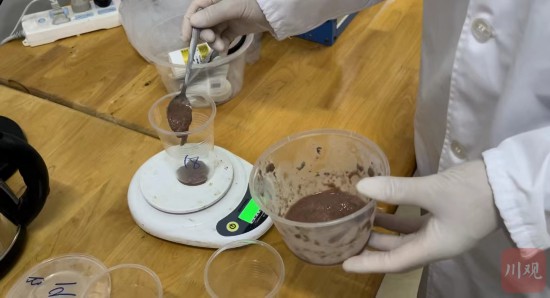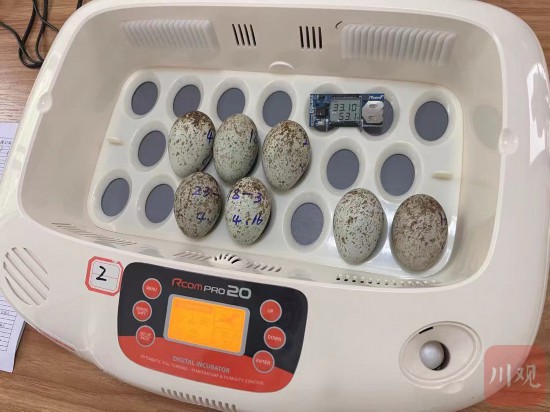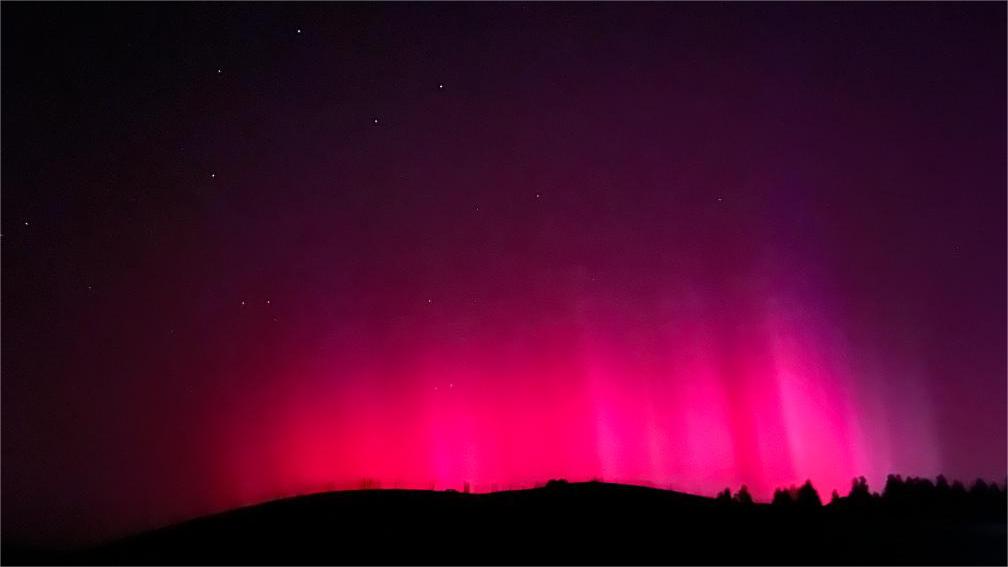Breeding center in SW China's Sichuan helps boost crested ibis population
A breeding center in Muchuan county, southwest China's Sichuan Province, celebrated the birth of a crested ibis chick on April 21, marking the facility's first successful hatching of the endangered species this year. The center now houses over 80 crested ibises, often referred to as "the Oriental gem."

Photo shows the first crested ibis chick born this year at the Crested Ibis Breeding Center in Muchuan county, southwest China's Sichuan Province. (cbgc.scol.com.cn/Chen Junling)
In the following 10 days, four more crested ibis chicks were born at the breeding center. Estimates suggest that the number of crested ibises at the center will approach 100 this year.
The breeding center, surrounded by lush greenery, is located near Muchuan Wetland Park.
Upon entering the center, visitors can see two rows of tall breeding cages on the left, divided into 24 "rooms" based on their function. Half of these rooms are dedicated to crested ibis couples, providing independent breeding environments for the birds during the breeding season.
The cages are equipped with ponds, trees, and perches to simulate the ibises' natural habitat. A total of 79 adult crested ibises reside in this area.

Photo shows the entrance of the Crested Ibis Breeding Center in Muchuan county, southwest China's Sichuan Province. (cbgc.scol.com.cn/Chen Junling)
The building on the right side of the center is primarily used for hatching and raising chicks.
Wu Yongzhong, a technician at the center, was preparing a variety of food for the crested ibis chicks at 1 p.m.
"These were mixed yesterday with the right proportions and refrigerated. The main ingredients include loach, northern snakehead fish, and egg yolk," explained Wu.

A staff member prepares food for crested ibis chicks at the Crested Ibis Breeding Center in Muchuan county, southwest China's Sichuan Province. (cbgc.scol.com.cn/Chen Junling)
The chicks are fed three times a day, with two of the feedings supplemented with vitamins. After feeding, Wu delicately cleans each chick and attentively observes their growth.
After caring for the chicks, Wu entered the incubation room, which contained multiple square incubators on a table, each with over 20 crested ibis eggs visible through transparent covers.
However, hatching is not as simple as waiting for the eggs to crack.
"During this period, we frequently encounter issues such as deformed eggs and low fertilization rates, which reduce the chances of healthy chicks hatching to less than 50 percent," said Wu.
To increase the likelihood of successful hatching, the staff must routinely rotate the eggs to maintain consistent heat distribution for the embryos. They also closely monitor the development of the embryos throughout the incubation period.

Photo shows crested ibis eggs in an incubator at the Crested Ibis Breeding Center in Muchuan county, southwest China's Sichuan Province. (cbgc.scol.com.cn/Chen Junling)
Before joining the breeding center in 2019, Wu was a giant panda keeper for many years. In his opinion, raising crested ibises is more challenging than raising giant pandas.
"We expect to hatch around 15 healthy crested ibis babies this year, bringing the total number at the breeding center close to 100," Wu said.
The crested ibis breeding center, which faced a newborn survival crisis last year, is now combining artificial and natural breeding methods. Adult ibises incubate their own eggs and receive assistance during rearing, leading to an improved chick survival rate, according to Wu.
The breeding center is also currently building a new aviary, according to an official from the Muchuan forestry bureau.
The 3,000-square-meter site will include ecological aviaries and training enclosures simulating the ibises' natural environment, becoming Sichuan's first training site for releasing crested ibises into the wild.

An aviary is under construction at the Crested Ibis Breeding Center in Muchuan county, southwest China's Sichuan Province. (cbgc.scol.com.cn/Chen Junling)
Dr. Yang Qionghua, technical director of the breeding center, said the site is projected to be completed this summer. After completion, the first group of around 30 adult crested ibises will be trained before being released into the wild.
Photos
Related Stories
- Crested ibis see growth in population, habitat area
- Improving ecology allows endangered crested ibises to thrive in Hanyin, NW China
- China's protection of crested ibises serves as global model for saving endangered species
- Crested ibises thrive in the wild in China's Shaanxi with habitat under sound protection
- Crested ibis population surges 1,000-fold over past four decades
Copyright © 2024 People's Daily Online. All Rights Reserved.









